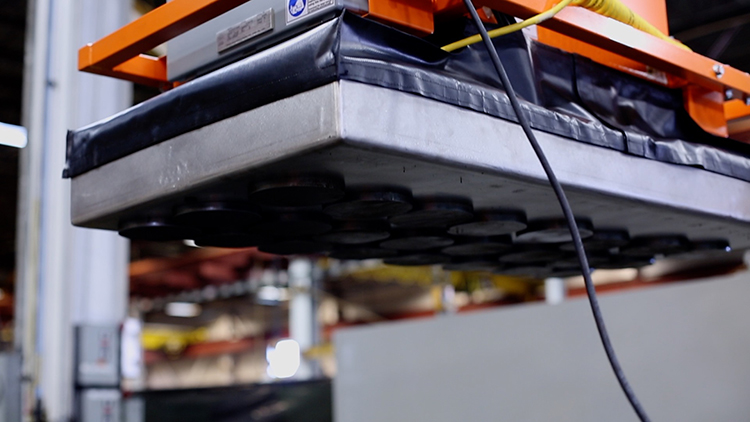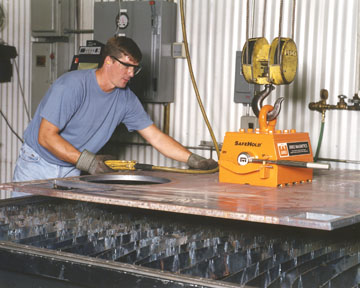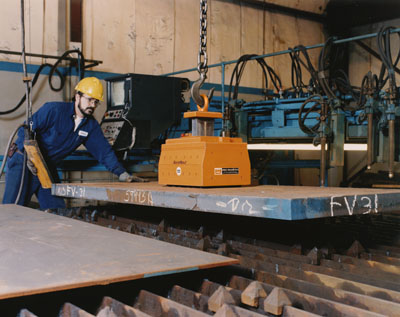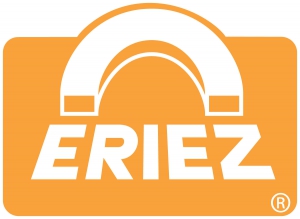
By: Andrew Kloecker, Eriez Metalworking Market Manager
Permanent lifting magnets are powerful magnetic devices that can load and unload burn tables and, when properly installed and operated, provide greater safety than many other mechanical material handling devices.
Permanent lifting magnets are ideal for carrying semi-finished products such as machined parts, castings, press molds, steel plates, bars, and tubes. They can also add safety and efficiency to cutting table operations.
Permanent magnet systems require fewer operators and helpers than other material handling solutions. They lift and transfer iron and steel parts without slings, hooks, or cables – and without marring the product’s surface. There is no requirement for an outside power source, thus no concern for dropping parts due to a power outage.
Using permanent lifting magnets reduces workplace hazards because the staff is less inclined to break safety protocols by climbing or walking on burn tables during loading and unloading tasks. More labor-intensive loading/unloading procedures bring greater risks of injury from tripping hazards and repetitive motions.
Magnet selection

There are a variety of key factors to consider when selecting a permanent lifting magnet. Dimensions, weight, shape, material thickness, temperature, surface condition and contact area of the item to be lifted must all be evaluated at the start of the selection process.
Material thickness is especially important as thinner steel does not allow full magnetic saturation, thus lower holding force. Derate values are model specific and can usually be found in product literature. The increased flexibility of thinner materials often requires multiple evenly spaced magnets on a spreader beam or magnets with large contact surfaces to maintain flatness and prevent peeling away from the magnet face.
Material temperature is important as the permanent magnet field strength is reduced as temperatures increase. As the magnet cools back down, it will typically return to full strength at room temperature. However, if rare earth magnets reach temperatures of 175 degrees F or higher, that loss of strength will likely be permanent.

Ceramic-based magnets have a higher temperature limit and are much better suited for burn table applications. These application details, plus process flow and floor space considerations, will help manufacturers develop a clear understanding of the safety and efficiency goals for the customer. Once a purchase is made, a short follow-up training on lift magnet operation, inspection, and maintenance will help assure the success of the new equipment.
Options
Permanent lifting magnets vary in size, capabilities, requirements, price, and more. Most are standard, in-stock models, available for immediate delivery. However, custom options and add-ons are available for specific applications. Pole Shoes for handling round tubing, pipe and bar stock, pole extensions for high-t applications, and contoured pole adapters for odd-shaped parts are just a few. Spreader beams and custom lift eyes are common as well to increase safety and efficacy in certain applications.
There are three common lift magnet categories to explore based on the application: lever-operated, automatic, and full coverage.
1. Lever-Operated
A lever-operated permanent lifting magnet, the most affordable option, is effective for handling single parts. Manually operated permanent lift magnets offer high capacity and versatility in their size and cost. They are available in both rare earth and ceramic.
As the operator flips the lever, the internal magnetic elements align to force magnetism into the part to lift it or pull the magnetism out of the part to release it. Manufacturers include handle locking mechanisms to prevent accidental part release. Some models have carefully designed circuits and levers that minimize and handle the backlash.
2. Automatic
Automatic permanent lifting magnets can be considered an upgrade over lever-operated magnets. These models have an internal actuator that extends and retracts with the lifting and lowering of the hoist.
The internal actuator serves as the lever and orients the magnetic elements to lift or release the parts each time the magnet is cycled. Since no operator is needed to flip an external lever, this style is an excellent selection for loading and unloading sheets and cutting parts from burn tables, and anywhere else operators have limited access. These models can be used singly or in multiples on a spreader beam. With ceramic construction and large contact areas, these models excel in elevated temperature cutting table environments.
3. Full coverage
Full coverage permanent lifting magnets take the automatic, hands-free operation to the next level as they can clear large areas of cut parts from a burn table in a single lift. Full coverage systems are designed to handle cut parts and skeletons as well, depending on sheet and table size. Full Coverage Magnets only require an overhead hoist and air or electric supply for system activation.
These powerful systems utilize a large full-contact magnetic surface area, with no gaps in coverage, to unload the table quickly and efficiently. Production facilities looking to gain maximum torch time can drastically reduce loading and unloading time and keep operators off the table by utilizing a full coverage system. The ceramic magnet circuit can withstand material temperature fluctuations and alleviates power failure concerns.
Maintenance
Regardless of the permanent lifting magnet you choose, operator training, a periodic inspection schedule, and basic proactive maintenance are crucial to maintaining peak safety and productivity and achieving years of trouble-free operation. Confirm your magnet complies with the guidelines found in ASME B30.20, Below the Hook Lifting Devices. Contact us for more information about permanent lifting magnets, email [email protected] or call 814-835-6000.
Sidebar: General Safety Guidelines
- The lifting magnet face and lifting magnet contact area on the load must be clean.
- No person should ever stand on top of a lifted workpiece.
- Do not use two lifting magnets simultaneously without the use of a properly designed spreader beam.
- Avoid placing the magnet in shear.
- The operator should avoid carrying the load over people.
- Do not allow load or magnet to meet any obstruction.
- Care should be taken to make certain the load is correctly distributed for the lifting magnet being used.
- Avoid uneven lifts.
Contact Details
Related Glossary Terms
- backlash
backlash
Reaction in dynamic motion systems where potential energy that was created while the object was in motion is released when the object stops. Release of this potential energy or inertia causes the device to quickly snap backward relative to the last direction of motion. Backlash can cause a system’s final resting position to be different from what was intended and from where the control system intended to stop the device.
- metalworking
metalworking
Any manufacturing process in which metal is processed or machined such that the workpiece is given a new shape. Broadly defined, the term includes processes such as design and layout, heat-treating, material handling and inspection.

